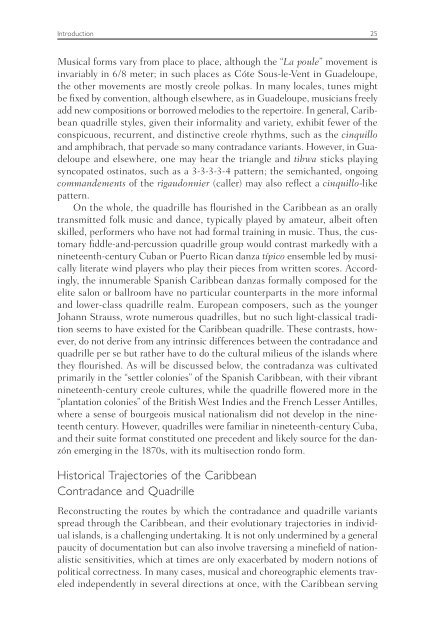Creolizing Contradance in the Caribbean - Temple University
Creolizing Contradance in the Caribbean - Temple University
Creolizing Contradance in the Caribbean - Temple University
You also want an ePaper? Increase the reach of your titles
YUMPU automatically turns print PDFs into web optimized ePapers that Google loves.
Introduction 25<br />
Musical forms vary from place to place, although <strong>the</strong> “La poule” movement is<br />
<strong>in</strong>variably <strong>in</strong> 6/8 meter; <strong>in</strong> such places as Cóte Sous-le-Vent <strong>in</strong> Guadeloupe,<br />
<strong>the</strong> o<strong>the</strong>r movements are mostly creole polkas. In many locales, tunes might<br />
be fixed by convention, although elsewhere, as <strong>in</strong> Guadeloupe, musicians freely<br />
add new compositions or borrowed melodies to <strong>the</strong> repertoire. In general, <strong>Caribbean</strong><br />
quadrille styles, given <strong>the</strong>ir <strong>in</strong>formality and variety, exhibit fewer of <strong>the</strong><br />
conspicuous, recurrent, and dist<strong>in</strong>ctive creole rhythms, such as <strong>the</strong> c<strong>in</strong>quillo<br />
and amphibrach, that pervade so many contradance variants. However, <strong>in</strong> Guadeloupe<br />
and elsewhere, one may hear <strong>the</strong> triangle and tibwa sticks play<strong>in</strong>g<br />
syncopated ost<strong>in</strong>atos, such as a 3-3-3-3-4 pattern; <strong>the</strong> semichanted, ongo<strong>in</strong>g<br />
commandements of <strong>the</strong> rigaudonnier (caller) may also reflect a c<strong>in</strong>quillo-like<br />
pattern.<br />
On <strong>the</strong> whole, <strong>the</strong> quadrille has flourished <strong>in</strong> <strong>the</strong> <strong>Caribbean</strong> as an orally<br />
transmitted folk music and dance, typically played by amateur, albeit often<br />
skilled, performers who have not had formal tra<strong>in</strong><strong>in</strong>g <strong>in</strong> music. Thus, <strong>the</strong> customary<br />
fiddle-and-percussion quadrille group would contrast markedly with a<br />
n<strong>in</strong>eteenth-century Cuban or Puerto Rican danza típico ensemble led by musically<br />
literate w<strong>in</strong>d players who play <strong>the</strong>ir pieces from written scores. Accord<strong>in</strong>gly,<br />
<strong>the</strong> <strong>in</strong>numerable Spanish <strong>Caribbean</strong> danzas formally composed for <strong>the</strong><br />
elite salon or ballroom have no particular counterparts <strong>in</strong> <strong>the</strong> more <strong>in</strong>formal<br />
and lower-class quadrille realm. European composers, such as <strong>the</strong> younger<br />
Johann Strauss, wrote numerous quadrilles, but no such light-classical tradition<br />
seems to have existed for <strong>the</strong> <strong>Caribbean</strong> quadrille. These contrasts, however,<br />
do not derive from any <strong>in</strong>tr<strong>in</strong>sic differences between <strong>the</strong> contradance and<br />
quadrille per se but ra<strong>the</strong>r have to do <strong>the</strong> cultural milieus of <strong>the</strong> islands where<br />
<strong>the</strong>y flourished. As will be discussed below, <strong>the</strong> contradanza was cultivated<br />
primarily <strong>in</strong> <strong>the</strong> “settler colonies” of <strong>the</strong> Spanish <strong>Caribbean</strong>, with <strong>the</strong>ir vibrant<br />
n<strong>in</strong>eteenth-century creole cultures, while <strong>the</strong> quadrille flowered more <strong>in</strong> <strong>the</strong><br />
“plantation colonies” of <strong>the</strong> British West Indies and <strong>the</strong> French Lesser Antilles,<br />
where a sense of bourgeois musical nationalism did not develop <strong>in</strong> <strong>the</strong> n<strong>in</strong>eteenth<br />
century. However, quadrilles were familiar <strong>in</strong> n<strong>in</strong>eteenth-century Cuba,<br />
and <strong>the</strong>ir suite format constituted one precedent and likely source for <strong>the</strong> danzón<br />
emerg<strong>in</strong>g <strong>in</strong> <strong>the</strong> 1870s, with its multisection rondo form.<br />
Historical Trajectories of <strong>the</strong> <strong>Caribbean</strong><br />
<strong>Contradance</strong> and Quadrille<br />
Reconstruct<strong>in</strong>g <strong>the</strong> routes by which <strong>the</strong> contradance and quadrille variants<br />
spread through <strong>the</strong> <strong>Caribbean</strong>, and <strong>the</strong>ir evolutionary trajectories <strong>in</strong> <strong>in</strong>dividual<br />
islands, is a challeng<strong>in</strong>g undertak<strong>in</strong>g. It is not only underm<strong>in</strong>ed by a general<br />
paucity of documentation but can also <strong>in</strong>volve travers<strong>in</strong>g a m<strong>in</strong>efield of nationalistic<br />
sensitivities, which at times are only exacerbated by modern notions of<br />
political correctness. In many cases, musical and choreographic elements traveled<br />
<strong>in</strong>dependently <strong>in</strong> several directions at once, with <strong>the</strong> <strong>Caribbean</strong> serv<strong>in</strong>g
















